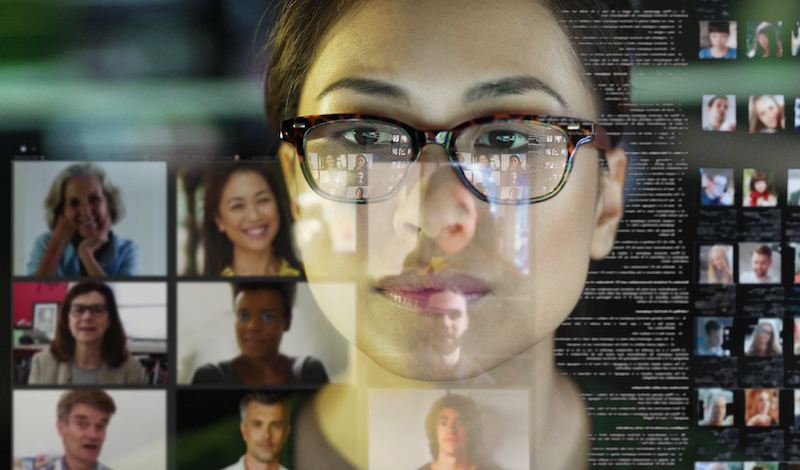
Scholars caution against judging credibility over video calls in immigration hearings.
When applying for asylum in the United States, immigrants typically have a single chance to prove the credibility of their claims in a hearing before an immigration judge. This hearing may be over Zoom or in person, where a judge assesses an applicant’s body language, such as eye contact and fidgeting, as signs of their credibility.
In a recent article, Liz Bradley of the University of Pennsylvania Carey Law School and Hillary Farber of the University of Massachusetts Law School, argue that such “credibility determinations” based on applicant demeanor are unreliable and fundamentally unfair— an issue exacerbated by the prevalence of video hearings.
Bradley and Farber explain that, to receive asylum, immigrants must prove that they have a well-founded fear of experiencing future persecution if they return to their country of origin. Their fear needs to be subjectively genuine, meaning a judge must view them as credible. Often, immigrants lack direct evidence of their past persecution to corroborate their stories, making the believability of their word essential.
Negative credibility findings can lead to denial of asylum and in some cases, life or death consequences for an applicant. Judges, however, are not equipped to evaluate truthfulness based on observed behaviors, Bradley and Farber argue. They note the average person can only decipher truth from lies based on behavioral indications with 54 percent accuracy— a figure which they claim can extend to judges in some cases.
And even in the absence of video hearings, credibility determinations contain implicit biases, including racial and ethnic biases, that lead judges to interpret ambiguous interactions with people of color negatively, Bradley and Farber state.
Bradley and Farber further explain that trauma — present in many of these cases —can cause flattened affect or memory deficits, which judges misinterpret as dishonesty. Language interpreters, which are required in 92 percent of immigration cases, can further distort a judges perception of credibility by misrepresenting an applicant’s tone and omitting their verbal cues.
Culture’s influence on behavioral cues compounds this inaccuracy, Bradley and Farber argue. Notably, judges receive little training on cultural competency, which can limit their ability to understand behaviors cues from foreign cultures. Bradley and Farber point, for example, to eye contact as indicating trust in Western culture, when in other countries it is perceived as a sign of being disrespectful.
Although judges must report which behaviors seemed not credible, they do not have to explain why they believe that a given behavior indicates untrustworthiness.
Judges’ credibility assessments are difficult to appeal successfully and are affirmed 96 percent of the time. This high rate is due to the prevailing view that a trial judge is in a uniquely advantageous position to assess a person’s credibility since they are viewing them face to face, whereas an appeals court can only review a written record of the hearing and evidence, Bradley and Farber explain.
Bradley and Farber argue that video hearings compound these issues, with immigration judges being 31 percent more likely to order deportation for applicants in video hearings than in person hearings.
For example, body language can be impossible to perceive over video, Bradley and Farber explain, although it accounts for over half of the meaning and understanding of language. Bradley and Farber also refer to studies showing that the visual presentation of an individual can be affected by camera angle, which can in turn affect perceived credibility.
These credibility issues created by video connections can bleed into weighing of evidence, Bradley and Farber warn. They explain how technical issues during a video hearing can lead to a phenomena called “cognitive fluency” where judges’ negative feelings about struggling to listen to a witness, for example, can be misdirected to their evaluations of evidence.
Furthermore, Bradley and Farber note that interpreters provide less accurate interpretation over video than in person. Interpreters, like judges, cannot perceive body language as easily over video and struggle to indicate to speakers to pause or slow their speech.
Background noises make it difficult for interpreters to hear, and when they are translating over video simultaneously with the judge speaking, their translation is projected at the same volume as the judge, which is difficult for listeners to distinguish. These issues may cause a judge to receive interpretation without important language cues that would make a demeanor assessment more accurate, Bradley and Farber claim.
Bradley and Farber argue that court challenges to video-based negative credibility determinations have not proved to be a viable remedy for this issue. Technical issues are usually not written down in the hearing record when they happen unless they are verbally announced, so appeals courts are unable to review them.
Bradley and Farber acknowledge that video hearings were crucial to allow cases to proceed during the pandemic. They also acknowledge ongoing advantages to remote hearings such as increased access to representation for those detained in rural detention centers and access to testimony from far-away experts.
Bradley and Farber argue, however, that the benefits of video hearings do not outweigh the ultimate compromise on fairness and impartiality. To address these issues, Bradley and Farber suggest prohibiting demeanor as a basis for a negative credibility determination in video hearings.
Such a prohibition would continue to allow virtual hearings and ongoing discussion about how to consider demeanor fairly in the future. To affect structural change, Bradley and Farber suggest that immigrants should be asked for consent before holding a hearing over video, and that video hearing recordings are made available for an appeals court to review so it does not accept the immigration court’s credibility determination without re-assessing the issues.
With these changes, Bradley and Farber hope for more fairness in the process of credibility determination and ultimately in asylum cases.



